Stunning Lack of Tranparancy in BLM’s and University of Wyoming’s Adobe Town Wild Horse Study
February 11, 2017BLM and University of Wyoming Continue Dangerous Radio Collar Study on Wild Mares
February 21, 2017The BLM Continues Lack of Transparency in Adobe Town Wild Mare Radio Collar Study
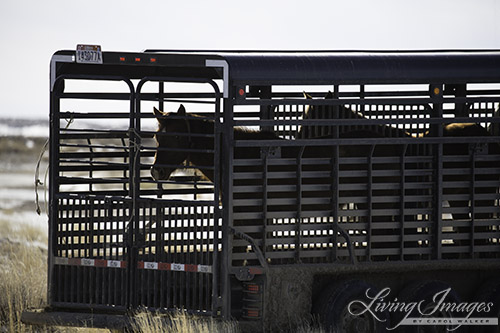
Only 3 mares in the trailer?
On Sunday morning I waited at the parking lot next to the corrals at the Rock Springs BLM facility. It was 1 degree above zero, and I was bundled up accordingly. I am the only member of the public there, unaffiliated with the BLM or University of Wyoming. One trailer and two trucks drive in front of me, and I am waiting for the other trailer. There are only 3 mares in this trailer, I am assuming three of the four mares that had radio collars put on on Friday. But there were 5 other mares that I had been told by Kate Schoenecker of USGS had not been collared because they were too young. In the Environmental Assessment, it states clearly that they were only going to collar mares 5 years old and older. Young mares who are still growing can be strangled by the collars. But where were the 5 other mares? They flagged me to follow, and I pulled out of the facility. When we took a break I asked where the other mares were. I was told they were still at the Rock Springs facility and they were being “re-evaluated.” What does that mean? They are either too young for the study, under 5, or they are not. Are they being kept for some other purpose? Both the EA and the BLM’s own press release state that none of the horses from Adobe Town are to be removed – they are all supposed to go back to the Herd Management Area. So what is the BLM not telling us?
These mares need to be released back to the area where they were trapped IMMEDIATELY.
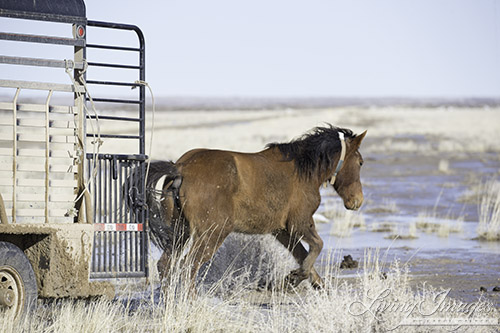
Robin comes out of the trailer
We drove to Bitter Creek Road, which is about 30 minutes from Rock Springs, and we started down the road. After we got off of the paved portion of the road, conditions got worse, from occasional mud to water and ice flooded areas. It was a challenging drive. After we passed Eversole Ranch, about 10 miles later the trailer stopped and the first mare was released, a little bay I named Robin. She ran as fast as she could once she hit the ground, only turning back to look at us when she had gone what she thought was a safe distance. There were no other wild horses in sight, and I learned that all three of the mares had been trapped about 30 miles south of this area.
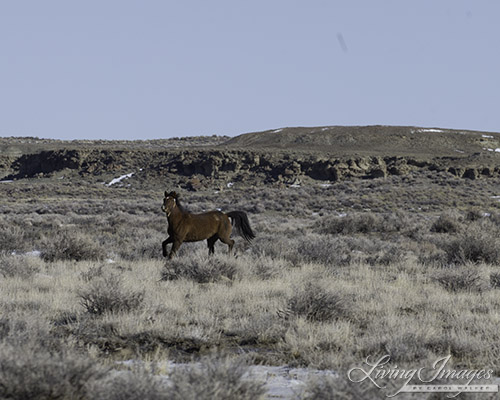
Robin looks back at us
We got back in our cars and continued driving for about 8 miles before stopping again to let another mare out of the trailer, this time a little sorrel I named Felicity. She turned around immediately after jumping out, looking for her friend, the grey mare in the back of the trailer. I noticed a cut over her eye that looked swollen. Any time you transport wild horses there can be injuries. It did not look deep and it did not prevent her from running off when one of the contractors shooed her away. There were no other horses around her either.
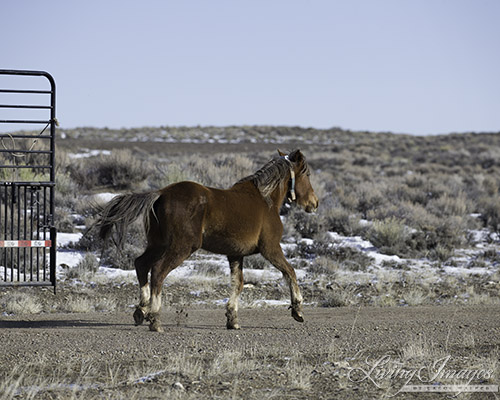
Felicity comes out of the trailer
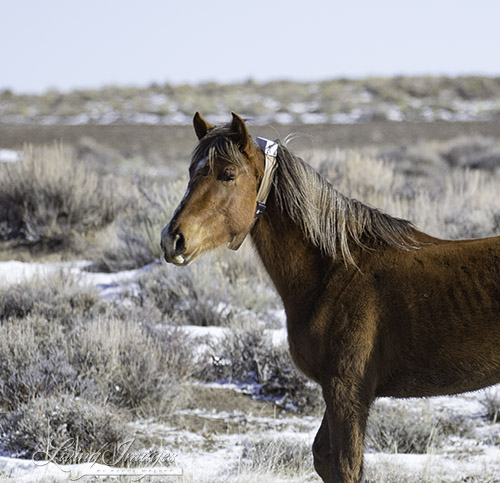
Felicity looks back at her friend in the trailer
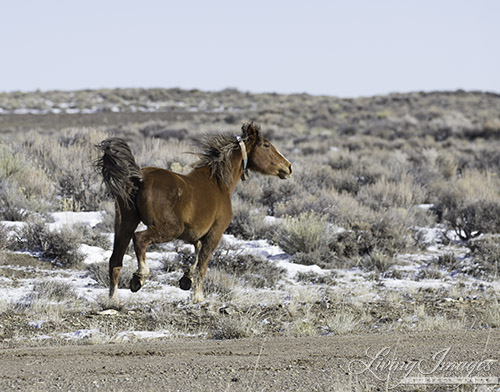
Felicity finally runs away
We continued driving as the road got worse for another 10 miles, almost to the state border with Colorado before letting the last mare go, a grey mare who was pure white who I named Ghost. She ran down the road past the cars and disappeared. We turned around carefully and went back out the way we came.
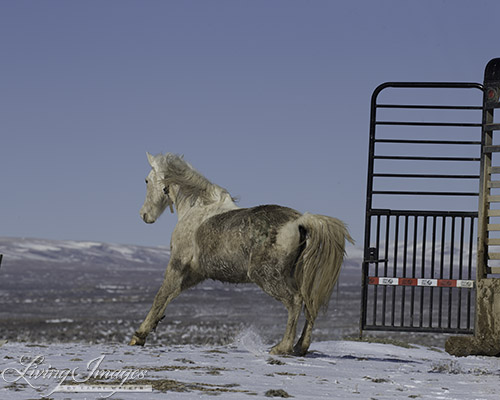
Ghost jumps out
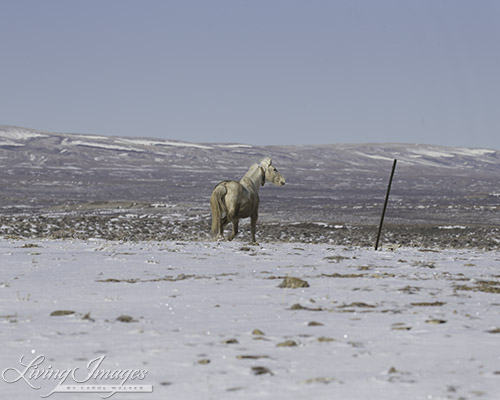
Ghost looks out, getting her bearings
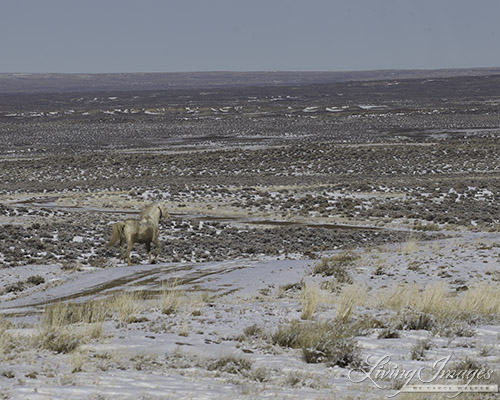
Gone!
On the way back, right in the area Felicity had been released I caught sight of a wild family at a run. They ran across the road in front of us, and the grey stallion in front was magnificent with his flowing mane. I hope that Felicity can meet up with them and join their family.
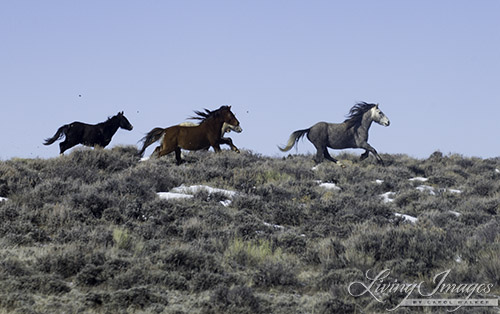
The wild family
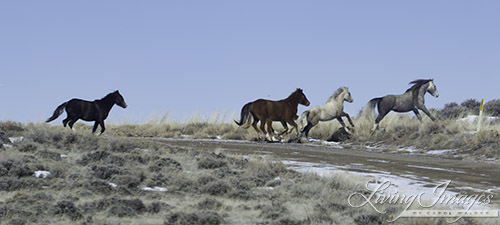
Crossing the road
We were going to meet up with the other contractors, who had been bait trapping in the northeast portion of Adobe Town who had loaded the grey mare with a collar at Rock Springs, then loaded up her family with her. They had held onto the family and were going to release them all together. After driving on the highway, we got onto muddy roads, and drove until we met up with a horse trailer full of horses. This was the grey mare and her family. they were moving quite a bit in the trailer, clearly eager to get out. We followed the trailer until they stopped and we positioned ourselves to watch them emerge, which they did at first tentatively and then faster. As they leaped out I saw a filly at the side of the grey collared mare who I named Dove, and was told she was her yearling filly. No doubt this is why they kept the family back so they could be released together.
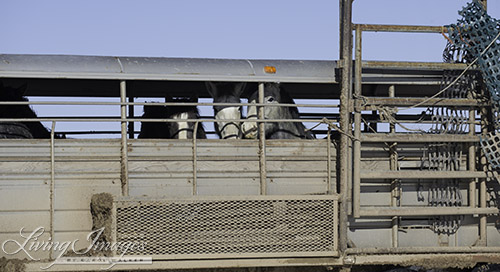
The grey family in the trailer
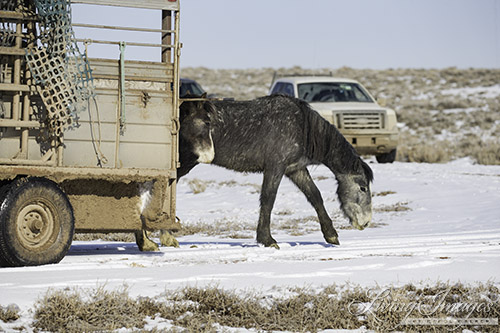
Tentatively they get out
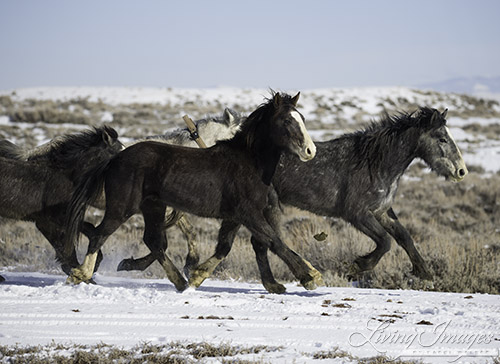
Running from the trailer
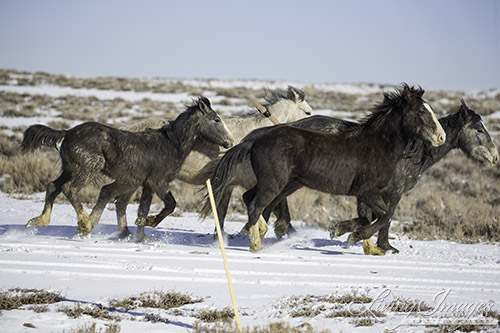
The collared mare Dove and her young filly bring up the rear
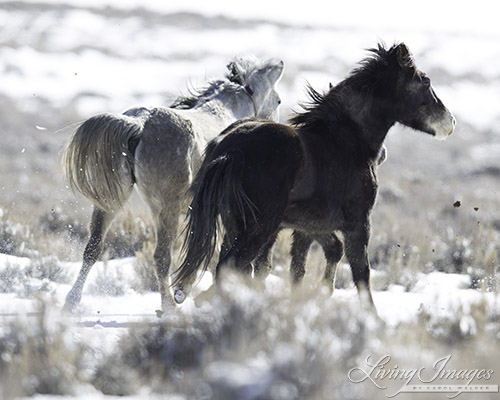
Going….gone!
They ran off over the hill, and I breathed a sigh of relief that all four were back home.
One thing that really puzzled me was that I saw piles of panels used for traps, all stacked on a semi. Neither team of contractors had a new trap set up. When I asked they told me some decision was being made at 7pm this evening, they did not tell me what. According to the BLM’s own web page on the bait trapping, they had trapped for only 5 days, starting Sunday February 5. They gathered by their own report 27 horses over the four days, and shipped 9 mares to the Rock Springs corrals. The information on the study in the EA said they would be trapping in 3-5 locations. Why then were they only trapping in two locations, and had not set up any traps after Thursday? In the EA, the BLM had written that if bait trapping “fails” they would go to a helicopter roundup. I hardly think that 5 days only is enough time to “fail.” it takes time to accustom wild horses to a trap and to let them get used to it and come in. That is what they are currently doing in Sand Wash Basin, where they have given far longer than 5 days to trap the horses. This seems to me to be a setup to fail. If they are not continuing to bait trap then they are getting ready to bring the helicopters in. Wild horses are injured and killed when driven with helicopters. There is no justification for subjecting the wild horses of Adobe Town to a helicopter roundup when they are not even over the Appropriate Management Level for their area.
The BLM should continue to use bait trapping if they have to finish getting 16 more mares for this ill-conceived research study, or better yet, they need to go back to the drawing board and redesign the study so that the researchers use non-invasive, safe direct observation, not dangerous radio collars.
Link to Daily Gather Reports:
Previous Posts:
Stunning Lack of Tranparancy in BLM’s and University of Wyoming’s Adobe Town Wild Horse Study
Equine Advocates and Animal Welfare Groups Challenge Adobe Town Wild Mare Experimentation
Please Comment to Stop the Dangerous and Cruel Adobe Town Wild Mare Radio Collar Study

3 Comments
Have there been any updates since these mares were turned out?
Unfortunately no. I have not seen them, and the University of Wyoming is unlikely to share their locations from their computers. I will be looking for all of them this summer. But can you blame them if they stay as far away from human beings as possible after this?
[…] the rest of this story HERE, including […]